Back to: 7: Finishing: The Optician’s Edge
Note To Your Future Self: This won’t make any sense now, but it might some day, and I really can’t think of anywhere else to mention it. When edging for a snap-in or pinch style Rx insert for a mask or sport frames, remember that the lens will actually be rotated a few degrees in the mounted position. If you have a lens with higher cylinder, a progressive, or a lined bifocal, you need to trace the insert while mounted in the frame – or – account for the rotation. I did a lot of Rudy Project, so I had an old damaged frame I kept around that I had trimmed down to fit well in the tracing unit. That way, when the insert was rotated out to snap in place things lined up like they should.
Like all of opticianry, visualization will be your best learning tool for this stuff. If you work in optical ask the lab person to show you this stuff. Then work through all this and then go back and ask to see it all again.
Note: If your edger is set to “AUTO” and has no reason to run a job on “MANUAL” then you would simply block a SV lens directly on its OC with the three red dots horizontal in the blocker.
Formulas for Single Vision Lens Finishing
Note: Frame PDs or the geometric centers of the eyewire openings are almost always wider apart than patient PDs are. This means that lenses are usually “decentered” “IN” or nasally.
BUT THIS IS NOT ALWAYS THE CASE SO BE CAREFUL!

A + DBL = Frame PD or FPD
Frame PD or FPD = Distance Between Centers or DBC (of eyewire opening)
It is simply easier to measure your A and DBL than to try to measure the middle of the eyewires since you have no reference points there.
Calculating Decentration for Binocular PD’s:
Your FPD minus the Patient Binocular PD/2 = Amount of decentration per eye
Example:
Frame PD = 72
Patient binocular PD of 64
72 – 64 = 8 / 2 = 4 mm per eye
Since the PD is LESS than the frame PD, (64 is less than 72) the lenses need to be moved IN 4mm per eye.
Decentration for monocular PD’s:
FPD / 2 = Monocular Frame PD (MFPD)
MPPD = Monocular Patient PD
MFPD – MPPD = Amount of decentration per eye
Example:
Frame PD = 72
Monocular Patient PD = 32/34
72 / 2 = 36
36 – 32 = 4mm in right eye
36 – 34 = 2mm in left eye
Since the patient PDs are both LESS than the frame PD the lenses need to be moved IN.
When working with a basic manual blocker or when blocking by hand:
For “IN” decentration
Right Lenses Are Shifted Right
Left Lenses Are Shifted Left
Since the lenses are blocked on the front, you shift a right lens right and a left lens left to shift the lens OC in towards the nose. Once you have placed a block on the lens, you can pick it up, hold it like you would be wearing it, and you will see that the lens OC has shifted nasally.
In all of the following images the X X X represents the three dots that the lensmeter places on the lens. The center X is the lens OC and the two outer X’s are how you keep a lens properly oriented for axis (if your Rx calls for one).
In the further examples below the lenses are in a manual blocker. Look for the millimeter scale for both vertical and horizontal movement. Horizontal movement is numbered in the scale along the top. For vertical movement you need to count the number of lines above or below the center. On this blocker you can adjust the line to mark horizontal movement.
C/L means Center Line.
Notice that every 5mm the line is a little darker than the others.
Where the “0” line and the C/L line meet is your starting point. In theory it is equal to the center of your eyewire opening.
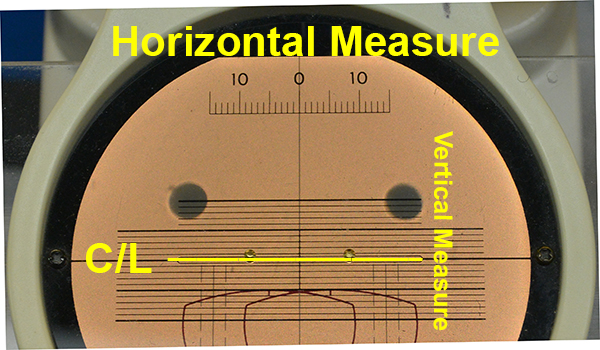
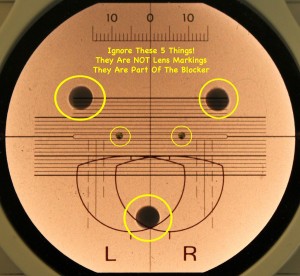
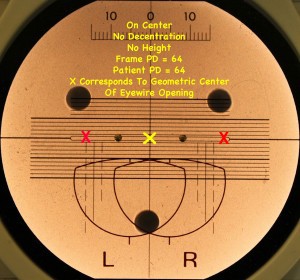

For the following examples these are two minus lenses. Where the two prisms meet is the lens optical center or OC. It is our goal to place the OC directly in front of the patients pupil. We do this by decentering (moving) the lenses within the frame eyewire opening. We use the patient PD and the frame PD to figure out how much to move them and in what direction.
Below is an example of lay-out calculations for a job order providing a binocular patient PD of 64.

To have the lens OCs end up 64mm apart we will need to shift the lens OC over 3mm in each eye.
We do this in the lens blocking device, or even by hand.
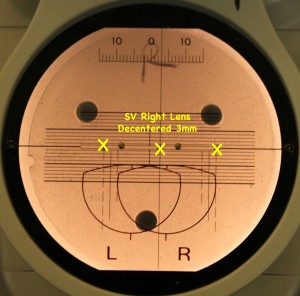
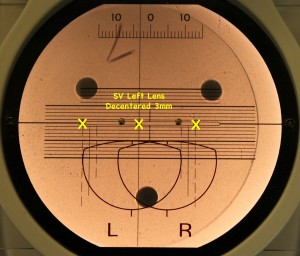
Once I have the lenses in this position I would load the blocker with a block (with a sticky “leap pad” attached) and stick the block to the front of the lens.
Below is an example of the layout calculations required for a job where the patient PDs have been given monocular.
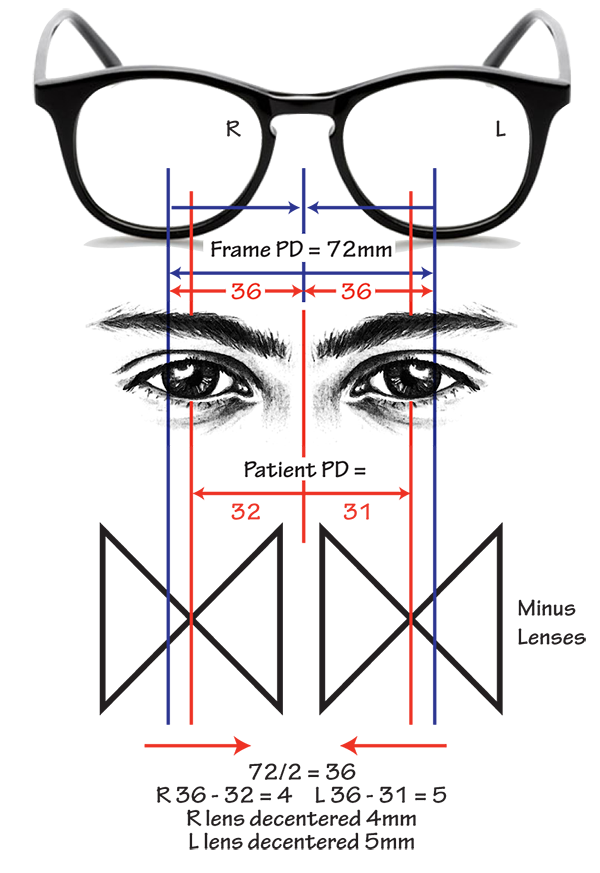
We need to shift the right lens 4mm and the left lens 5mm to place the lens OCs at the proper location.
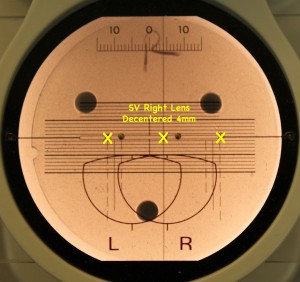
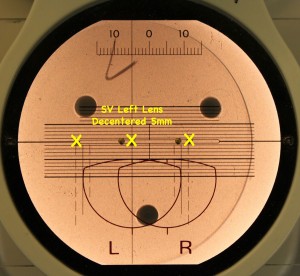
Once I have the lenses in this position I would load the blocker with a block (with a sticky “leap pad” attached) and stick the block to the front of the lens.
Again, if you take the blocked lens and hold it as you would BE WEARING IT – RIGHT IN FRONT OF RIGHT and LEFT IN FRONT OF LEFT – you will see that the center dot or OC has been shifted nasally. Think of the center of the block as the center of the frame eyewire opening of FPD.
Here is the answer key to the Single Vision Finished Uncut Lens Inventory Worksheet: C, A, E, D, B
Working with prism in SV lenses is covered in the prism section. Prism in lined multifocals and progressives is quite easy.
